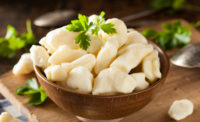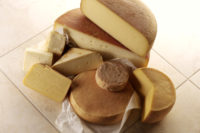Cheese produced with milk from pasture-fed or grass-fed cows is noticeably different from cheese made from conventional milk: It has a “grassy” note, a golden color, and a unique fat composition. The yellow or golden color comes from the high amount of beta carotene in grass. Cows can’t break down beta-carotene, so some is passed into the milk. Cheese from pasture-fed cows also contains higher levels of omega-3 polyunsaturated fatty acids and conjugated linoleic acid.
Some countries such as Ireland and New Zealand predominantly use pasture grazing to feed their cows. Irish dairy producers promote their butter and cheeses made from pasture-fed cow’s milk and tout the taste and nutritional benefits of these products. Here in the United States, there are several high-profile cheeses made from pasture-fed cow’s milk, including Pleasant Ridge Reserve, produced by Uplands Cheese Company, and the European-style artisanal cheeses made by Saxon Creamery.
What is ‘pasture-fed’?
What is the definition of pasture-fed cows? Can they be fed some hay or silage, or does their diet need to be 100% pasture?
There are no formal definitions, but some cheese labels do use terms such as 100% pasture-fed. Presumably, that means the cheese is made from cow’s milk produced only during the grazing season. When those cows are not producing milk or when the milk is used for other products, then hay or silage can be fed to the cows.
Organic milk and cheese are arguably mostly made with pasture-fed cow’s milk. According to the USDA’s Organic Livestock Standards, “Organic ruminant livestock — such as cattle, sheep, and goats — must have free access to certified organic pasture for the entire grazing season.”
Typical US cow diets
Most cows in the United States are fed a diet of total mixed rations (TMR), which is a blend of forages, grains, protein feeds, minerals, vitamins, and feed additives. TMR has proven to be a very efficient way to provide all the nutrients a cow needs to be healthy and have high milk production levels.
One distinct disadvantage of milk from pasture-fed cows is that it is available only when there is fresh grass, which causes “ups” and “downs” in its production. This also impacts the types of cheese products that are usually made with pasture-fed cow’s milk (e.g., fewer fresh cheeses and more aged varieties).
In addition, there may be a perception that pasture-fed cows have less of an impact on the environment, but this may not necessarily be the case.
Cows produce less milk (daily, as well as over a year) on a pasture diet than cows fed on TMR. Therefore, with TMR diets, fewer cows are needed to produce the same volumes of milk, and fewer cows result in reduced greenhouse gas emissions and less usage of water and crops, etc. A study conducted by the University of California-Davis compared milk production 50 years ago in California to current milk production in the state; it found that producing similar quantities of milk today compared to 50 years ago results in 50% less greenhouse gas emissions.
That said, there are certain geographic regions where pasture grazing is an attractive means to reduce milk production costs. I mentioned Ireland and New Zealand, where climates are ideal for pasture grazing. Here in Wisconsin, we have ideal land for pasture grazing for significant parts of the year, and some of our cheesemakers use this milk to produce special high-quality cheeses.
In closing, I want to acknowledge that cheese produced from pasture-fed cows provides a good opportunity to differentiate a product. Consumers are increasingly interested in specialty cheeses, and marketing a cheese as being made with milk from “grass-fed” or “pasture-raised” cows might help it stand out in the dairy case. Maybe in the future, we will even see cheesemakers, or regions of cheesemakers, promote the “terroir” of their grass-fed cheeses in a vein similar to winemakers.




